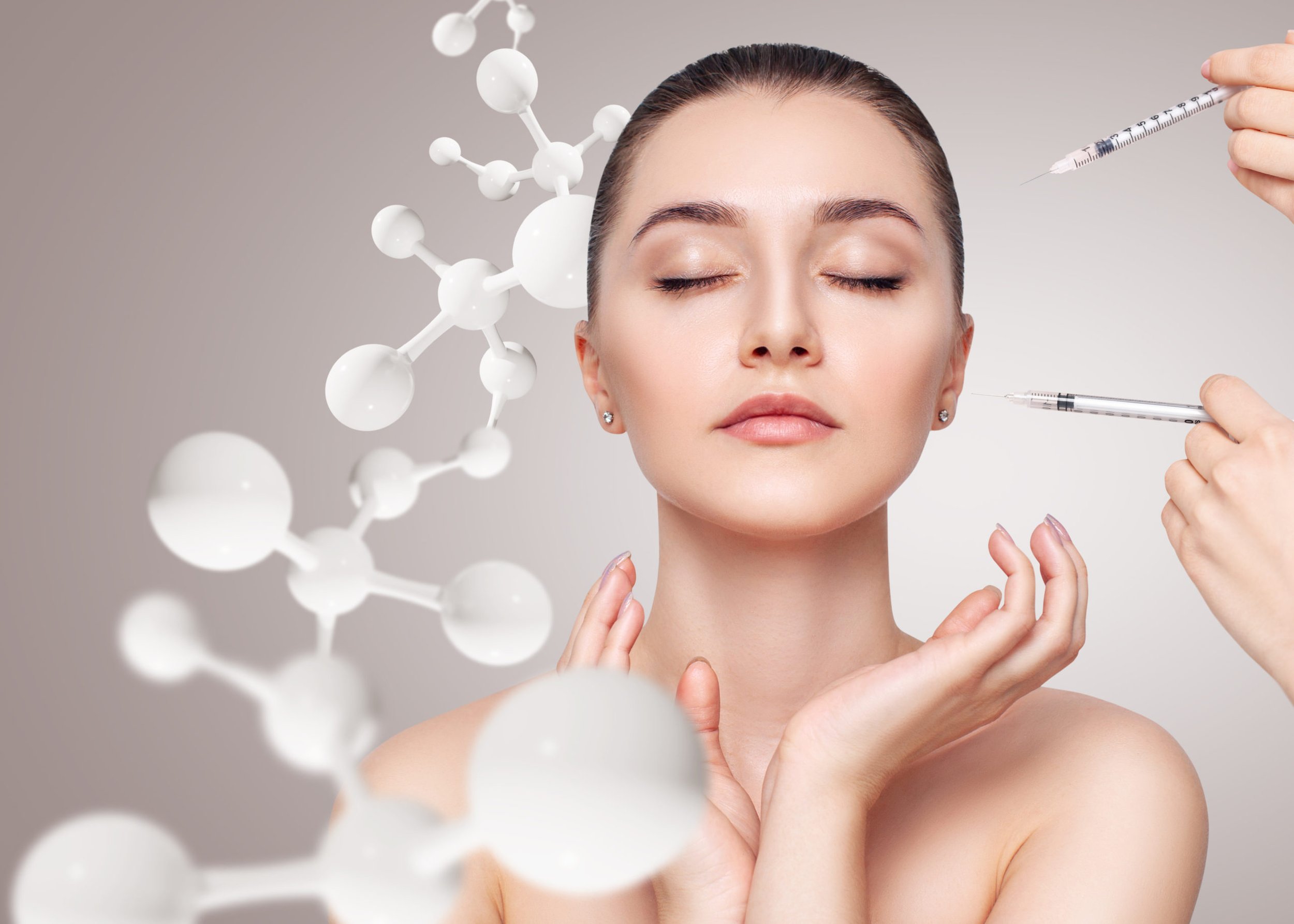Dermal Fillers: All You Need to Know
Dermal fillers are one of the best alternatives to minimize the loss of volume and sagging associated with aging, as well as to improve certain facial features and achieve fuller lips, pronounced cheeks, and even harmonize facial areas through shaping.
At Skinfinity by Hiba Rihan, we offer the best non-surgical facial rejuvenation techniques. Advances in understanding the aging process, combined with modern dermatology, have allowed the development of various techniques to counteract the effects of time.
In this opportunity, we will provide details about dermal fillers, the various materials used, commonly treated areas of the face, and much more. Based on your own perception, you can decide if this treatment is right for you.
Why Dermal Fillers?
The loss of facial volume is an inevitable part of the aging process. There is muscle atrophy, bone resorption, decrease and redistribution of subcutaneous fat, changes that affect skin turgidity, and the appearance of facial grooves and signs of aging.
In addition to biological factors, there are external factors such as ultraviolet radiation, responsible for the phenomenon of photoaging. Sometimes we may be dissatisfied with certain areas or features of the face.
But thanks to aesthetic medicine, with small changes and the use of appropriate materials and equipment, many imperfections can be improved without surgical intervention. A significant advancement in aesthetic medicine.
What Are Dermal Fillers?
Dermal fillers are substances that are injected or introduced into the skin or soft tissues. The use of dermal fillers is diverse, beyond aesthetic purposes, they contribute to improving physical, mental, and overall quality of life.
Application of dermal fillers in a male patient
Among the most common uses are:
Treatment of atrophic scars secondary to surgeries.
Trauma.
Acne.
Cosmetic treatment of facial wrinkles or vertical lines between the eyebrows.
Enhancing facial contour and lips.
Facial deformities.
Types of Dermal Fillers
There are various materials that can be used as dermal fillers, all of which are mentioned here are approved by the Food and Drug Administration (FDA) and the Spanish Agency of Medicines and Medical Devices (AEMPS).
We can divide them into two main groups: temporary and permanent:
Let's briefly discuss the most common ones:
Bovine Collagen as Dermal Filler:
It is the main component of the human dermis, accounting for 70-80% of the tissue. It diminishes with age, leading to changes in its structure from type I to type III, indicating a state of degradation that promotes the development of wrinkles.
Depending on its source, it is known as bovine, human, or porcine collagen, each with different properties. For products of animal origin, tolerance should be tested for each individual before treatment.
Collagen is often used to treat wrinkles, both superficial and deep, especially fine wrinkles.
Hyaluronic Acid (HA)
In 1934, hyaluronic acid was obtained from cow's eyes, but it wasn't until 1981 that the FDA authorized bovine collagen as a filler for cosmetic use.
Hyaluronic acid is present in the extracellular matrix and is entirely compatible with our organism. It has hydrophilic properties, meaning it attracts and binds to water, making it an excellent filler material that achieves significant increases after injection.
The chances of allergic reactions are very low, unlike collagen which can induce allergic reactions.
Calcium Hydroxyapatite
Also known as calcium hydroxyapatite, it has an advantage over the previous two as it lasts longer. It is produced from synthetic bone, making it fully compatible with the body.
It has marked viscoelastic properties and can act as a bio-stimulant for collagen production for 1 to 2 years after application.
Poly-Lactic Acid
This is a slowly absorbable, biodegradable compound. It stimulates collagen production, generating greater volumes over time. Its long action period greatly reduces the frequency of touch-ups.
Polymethylmethacrylate (PMMA) Microspheres
Belonging to the group of permanent fillers, it consists of PMMA microspheres suspended in a matrix of bovine collagen plus lidocaine. Since it contains a product of animal origin, a tolerance test is necessary.
PMMA stimulates the production of the body's own collagen and encapsulates the microspheres.
Where Are Dermal Fillers Applied?
Now that we have an idea of the dermal filler materials, let's move on to the most interesting part: the areas that can be improved with these compounds.
Dermal Fillers for Nasolabial Folds
This is the expression line that most of us are familiar with. It starts from the edge of the nose obliquely and goes down to the corner of the lips, commonly known as the smile lines.
Since we can't stop smiling, dermal fillers have come to our rescue. The most commonly used fillers for correction are polymethylmethacrylate microspheres with bovine collagen and hyaluronic acid.
Dermal Fillers for Lips
Dermal fillers address various aspects of the mouth area.
These include the corner of the lips, the philtrum (the vertical groove in the middle of the upper lip that connects to the nose), marionette lines that appear below the corners of the lips, and the vermilion (the red part of the lips). It is used to fill the lips, especially when one appears smaller than the other.
Dermal Fillers for Scars
Hyaluronic acid injections can improve the appearance, especially in the case of atrophic acne scars. Polylactic acid has also been used with good long-term results. The recommendation is small doses in frequent sessions.
It is particularly important to understand that the type of dermal filler to be used and the technique employed by the specialist depending on the specific considerations of each case.
Dermal Fillers for Under-Eye Circles
The depression formed below the orbital edge, starting from the tear duct, descending obliquely and ending at the level of the pupil, giving patients a tired and unhealthy appearance.
In aging, it facilitates the protrusion of bags under the eyes, sagging, and cutaneous atrophy, a common issue among patients aged 30 to 40.
As this is such a delicate area due to its proximity to the eyes, it is essential to use dermal fillers that generate minimal side effects. Most interventions are performed with hyaluronic acid.
Before the Application of Dermal Fillers
Educate yourself about the treatment; it is important that your expectations align with the results that the intervention can achieve.
Consult a specialist who will gather all your medical information; if you have sensitivities or allergies to materials or anesthetics.
Avoid drugs that can cause bleeding, such as anticoagulants and vitamin K chelators, for at least 10 to 14 days.
Refrain from the use of non-steroidal anti-inflammatory drugs and vitamin complexes with vitamin E.
Put Your Health in Expert Hands
Take care of your health and get the best results by going to a specialist who will provide individualized treatment, with specific instructions for your case, administering the right dermal filler option for you with the correct technique and dosage.
At Skinfinity by Hiba Rihan, we will guide you on the realistic results that can be achieved, always aiming for natural results, avoiding side effects, with subtle yet significant modifications to the face without distorting or causing harm.
If you are looking for specialists in Aesthetic Medicine in Kingston upon Thames, London, Surrey, Skinfinity by Hiba Rihan is the place for you, as we have over 14 years of experience to support our results.
Still not sure which treatment is best for you? Request a medical evaluation, HERE, it's free!






